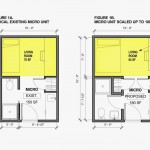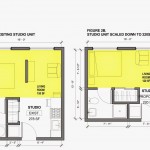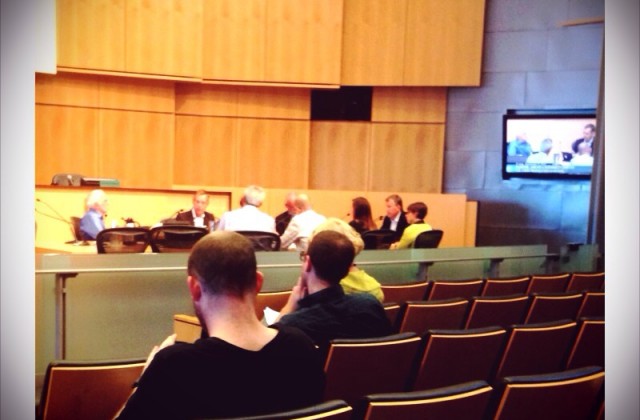Micro Legislation: An Architect’s Perspective
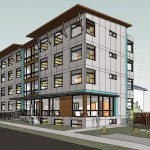 |
| Marion Micro Housing by Neiman Taber |
In response to the ongoing controversy over micro housing, Councilmember Mike O’Brien has proposed new legislation that would significantly change the rules for micro housing development in Seattle.
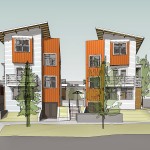 |
| Ravenna Micro Housing by Neiman Taber |
Current micro housing development is mostly built in the form of congregate housing (private sleeping rooms with shared kitchens and other amenities) and produces an average unit size of about 150 ft.². Councilmember O’Brien’s proposal would ban private development of congregate housing in LR zones, replacing them with conventional studio apartments with a minimum average size of 220 ft.². Development under this new proposal would result in a unit density roughly two-thirds of what is typical today.
|
Zone
|
Units allowed per square foot of lot area by category of residential use
|
|||
|
Cottage Housing Development (1) and Single-family Dwelling Unit
|
Rowhouse Development
|
Townhouse Development (2)
|
Apartment (3)
|
|
|
LR1
|
1/1,600
|
No limit
|
1/2,200 or 1/1,600
|
1/2,000
|
|
LR2
|
1/1,600
|
No limit
|
1/1,600 or No limit
|
1/1,200 or No limit1/230
|
|
LR3
|
1/1,600
|
No limit
|
1/1,600 or No limit
|
1/800 or No limit1/150
|
 David Neiman is the principle of Neiman Taber Architects, a residential architecture firm specializing in housing adapted to the Pacific Northwest climate. David was also been a leading (and successful) proponent of making significant changes to the multi-family code
David Neiman is the principle of Neiman Taber Architects, a residential architecture firm specializing in housing adapted to the Pacific Northwest climate. David was also been a leading (and successful) proponent of making significant changes to the multi-family code
Q13 on Microhousing: Determining How Other People Live
Last night C.R. Douglas reported on our efforts to defend microhousing against the onslaught of single-family resistance to a housing product that has been very successful. I thought the report was very fair and balanced. Here’s what I said:
“It’s a choice that people are making to say, I want a smaller space, pay less for it, in a hotter, transit-friendly, cool neighborhood in Seattle,” said Roger Valdez of Smart Growth Seattle. “The only complaints are from people that don’t live in them, that want to control and determine how other people live.”
The report highlighted why neighborhoods were upset, but also made it clear there are waiting lists to move in to microhousing buildings. Something that elicited amazement from the anchors. We’ll continue to do what we can to persuade Councilmembers that they should support a good thing. Keep microhousing a plentiful housing choice! Contact Councilmembers now!
Scott Shapiro on Micros: Enact the Best Public Policy for the Community
Smart Growth Member and sponsor Scott Shapiro sent this letter to the Mayor and Seattle City Council. It makes a good summation for why the City Council needs to act in a responsible way that will keep microhousing as a viable choice for people who want to live in our city. You can echo Scott’s views or convey your own by e-mailing the City Council.
Dear Councilmembers:
As you consider legislation to further regulate micro-housing and congregate residences, please consider each specific policy decision as many have a negative effect on the availability and affordability of this workforce housing type. Together, they could effectively kill this housing type altogether. For those of you who were not in attendance at the beginning of last Friday’s PLUS hearing, attached are my public comments that highlight my specific concerns. Based on the discussion at the hearing, I’d like to further address the following:
Minimum Average Net Square Foot Requirement – The proposed 220 sf requirement is totally unnecessary from a policy standpoint as it will produce less housing at higher cost per unit. The SBC (Section 1208.3) requires that every dwelling unit have at least one room of not less than 120 sf. However, a sleeping room need only to be 70 sf so when you add all of the other required provisions (e.g., bathroom, closet, food prep areas), it ends up being over 120 sf as currently written in the code. That model has worked well for some customers who have chosen to live in less space and pay less. Please continue to give the public that choice by eliminating the arbitrary minimum average 220 sf provision in DPD Director’s Rule 6-2004 and this proposed legislation.
Sink Requirement – There is no credible public policy or health policy reason to require two sinks in such a small unit (one in the bathroom and one in the sleeping/living room). Currently, hotels, dorms, and other apartments don’t have this requirement. Why would you impose it on this small unit? One sink in the amenity area is enough.
Design Review – As indicated in my testimony, the proposed new requirements for this flawed process are too low. Streamlined Design Review shouldn’t be implemented until a 12,000 sf building and full Design Review shouldn’t be implemented until 40,000 sf. The cost, timing, and risk otherwise makes creating micro-housing more difficult and less likely.
Congregate Food Preparation Prohibition – Why can only 25% of the congregate residences have a food prep area? Why create two classes of tenants: those with food prep areas and those without? Why can only certain classes of owners (e.g. public and nonprofit entities) create this? Most development is done by the private sector. Why limit who can create what is needed? I’m currently in early discussions with a nonprofit to build congregate housing that would be privately owned but will provide housing for this nonprofit. Based on this legislation, I would be prohibited in providing a food prep area in each sleeping room. That hurts the nonprofit and its customer. All congregate residence should be allowed to have food prep areas in the sleeping rooms regardless of who builds it or owns it.
Bicycle Parking – Based on my experience, one bicycle stall per four sleeping rooms is more than adequate. Requiring more than that – and having to put it indoors – takes away space for sleeping rooms and adds unnecessary costs that many tenants don’t need and wouldn’t want to pay.
RPZ Parking Permit – In addition to one parking permit per Small Efficiency Dwelling Unit (SEDU), each SEDU should also be allowed one guest pass. Two people may live in a SEDU. At the very least, a tenant should be able to allow a guest to park when visiting. These two are still just half of the four allowed for a unit over 400 sf.
Car Parking – No additional parking should be required. Changing the environmentally forward policy created over half a dozen years ago to not require parking in Urban Centers or Urban Villages with frequent transit was the right long-term public policy decision from a financial, environmental, health, and social perspective. It takes years to change the built environment let alone peoples’ mindset to accept and embrace this change in an increasing dense urban environment. If there are not enough buses then fund more buses. That is a lot less expensive than incentivizing and building the infrastructure for more single driver cars. We need more density so more citizens take the public transit (e.g., Link Light Rail, Streetcar, Metro buses) that the City and region has heavily invested in. Don’t walk away from that commitment based on the reality of more people living in Seattle.
I’m happy to talk with you in greater detail at any time. Please consider enacting the best long-term public policy for our community irrespective of electoral politics.
Thanks,
Scott
Council on Microhousing: Why Lead, When We Could….Follow?
Last week the Seattle City Council started consideration of new regulations on microhousing that bear no relationship to any actual policy problem. In fact, the actual policy and economic challenge the city faces, housing people affordably, will be harmed by the legislation. Rules limiting unit size, mandating car and bike parking, more review and process for microhousing, and more sinks, will mean less (if any) microhousing at a higher price. There is one “problem” the Council is solving, however. They’ll be a lot fewer new housing choices for people moving to some Seattle neighborhoods; just what the neighborhood lobby has been pushing for. Here’s a rundown of some of the comments and proposals being made by Councilmembers that make it look like microhousing might be going away.
Regulating Unit Size
There has not been one single report of anyone harmed by the size of microhousing. The data show just the opposite: zero vacancy rates and waiting lists are the norm for microhousing buildings. People like them. And when they don’t, they eventually move somewhere else. Councilmember Burgess noted at last weeks meeting, with wonder, that Seattle has the smallest room sizes in the country. It’s true, a fact that puts Seattle in first place in housing innovation, with places like San Francisco and New York trying to catch up to us. Burgess reminds me of Dr. Evil: Why be in first place, when we could be in….third?
Councilmember Mike O’Brien made it quite clear at the meeting that the size minimums for microhousing are really a politically safe way to impose what the neighborhoods want, a density limit, meaning less housing when demand for housing is going up. O’Brien made this comment at the same meeting where he moved on a density minimum for development in transit areas. O’Brien takes density that’s working away, and then mandates it where it isn’t feasible. Welcome to the mad, mad, mad world of Seattle City Council economics.
The truth is that there is no need to regulate room or unit sizes. This simply means less housing in the same building envelope with fewer renters to offset the costs of land, financing, and construction. It means higher prices and will make many projects infeasible, something we’ll post more about later.
Bike and Car Parking
Council Tom Rasmussen’s comments at the meeting reminded me of a 1968 ad making fun of the idea of a Vice-President Spiro Agnew: they would be funny, if it weren’t so serious. Rasmussen said, with an odd smile, that as long as busses were so full, people couldn’t ride them. Those people left behind because of full buses will need to drive, so we should require more parking in transit areas. Apparently the Chair of the Council’s Transportation Committee seems to have given up on the idea of transit as a transportation solution; more parking is the answer.
And then Councilmember Clark began talking about bike parking. Shouldn’t there be at least a .75 ratio of rooms to covered bike parking spots? Why? Let’s see what other cities are doing, they asked. But as I pointed out, other cities don’t really have microhousing; we’re the leaders. Council can come look at almost any microhousing project and bike parking is set by demand. In my building there are 7 spots and 3 bikes. If more bike parking were needed, residents would demand it and builders would provide it.
Adding additional parking, as we’ve pointed out, costs as much as $40,000 per stall for a housing type that has very little customer demand for parking. The whole selling point of microhousing is it’s affordability and it’s convenience for people who don’t drive. Requiring parking in microhousing is like requiring someone with a peanut allergy to buy a jar of peanut butter every time they buy a loaf of bread; it’s not something they want to pay for, and the certainly don’t need it.
Units, Rooms, Square Footage, and Process
The Council seems to have amnesia about its own policies. A few years ago, the Council adopted a regulatory reform package that raised the unit count threshold for SEPA review. The thought behind this change was that SEPA review assumes an environmental impact from growth; but growth in transit areas, by definition, is a positive thing. Raising the threshold would reduce costs and encourage growth where we want it.
But the conversation in Committee last week was all about how to change microhousing in a way that would expose it not only to full design review (something that will raise rents), but also SEPA review and appeal. Angry neighbors are sure to exploit the appeals process to its limits, discouraging microhousing and raising its price if it does manage to get built.
Our proposal is that the best way to measure impact on existing residents is the relative size of the building, meaning square footage, not unit count, should trigger design review. Additionally why expose microhousing to SEPA review when other types of housing are now exempt from it because more housing is being encouraged?
One Sink, Two Sink, More Sinks are Better
What can I say about this that I haven’t already covered before? Residents have not demanded more sinks, and there is zero evidence in scientific literature or even anecdotally that having one sink in microhousing has even led to so much as someone getting the hiccups. Yet, the Council is considering the idea of forcing more sinks in to microhousing.
Politics Pure and Simple
What the City Council is doing is trying to regulate something that has already been doing a great job handling growing housing demand in some of Seattle’s hottest neighborhoods. We lead the country in doing this. But angry single-family neighbors (who have zero microhousing units in their zone) are driving the Council to rule and regulate the innovative solution into extinction. Council’s efforts to try and seem reasonable in responding to the red herrings offered by enfranchised neighbors, will result in fewer more expensive units because of size limits and excessive process and reviews imposed on no other type of housing.
Council thinks the angry neighbor vote can be won by squashing microhousing.
The Council should praise the innovation that has created microhousing and find a way to allow it to keep working. Instead, they are doing almost everything they can to make it harder to build, more expensive, and, in the end, more scarce and costly to renters. As I’ve pointed out, the Council seems pathologically averse to new, innovative ideas. We’ve done the math, showed the impacts, but they simply aren’t listening.
Forterra Supports Microhousing
Forterra, Washington’s leading land conservation organization, supports microhousing.
In a letter sent to the City Council today, Forterra executive director Gene Duvernoy said,
As Forterra recognized a decade ago in the Cascade Agenda, accessible, welcoming cities are key to our region’s sustainability and the preservation of the working and wild landscapes critical for our sense of place and adaptation to climate change. That said, our cities must also serve all our citizens—both those who may have been here a very long time and those who just moved here. Changes require an understanding and respect for perspectives old and new.
Forterra also agrees that the size of microhousing should remain flexible.
Decreasing the current minimum unit size and allowing the inclusion of kitchen or food preparation areas to be flexible to meet market demand. Such flexibility will allow for more housing choices and options to reflect the desires of new residents and the impact of technology and lifestyle in how we live today.

